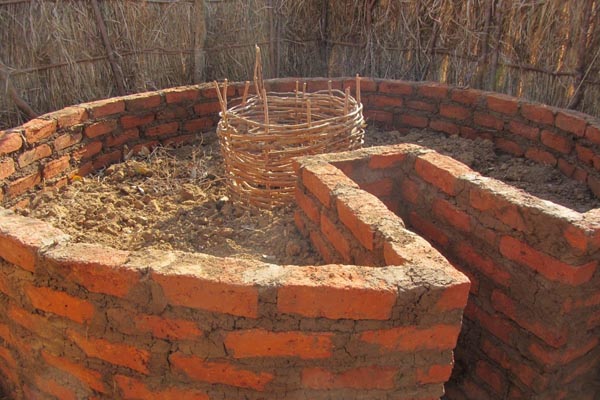Filius Jere | September 10, 2018
When Vashity Khumalo attended the funeral of a distant relative in the nearby village of Nyamiya, she saw a fence of vegetation that looked like an enclosure for keeping goats. She walked toward it and peeped inside but, to her surprise, there were no goats. Instead, she saw a raised circular structure made of burnt bricks. The structure was filled with soil and had vegetable plants growing on top.
At the time, she wondered why vegetables were growing in such a structure, but now she realizes it was a home vegetable garden.
Mrs. Khumalo says the garden contained vegetables that are scarce in the dry season. She adds that many families in her village are malnourished because they don’t often eat meals with enough nutritious vegetables. She says, “Ensuring that the family has good nutrition is a very big challenge for us women in the rural areas … there is always a need to have fresh vegetables.”
Mrs. Khumalo comes from Ngilile village in the Petauke district of eastern Zambia. Malnutrition is a challenge for many families here.
After the funeral, Mrs. Khumalo returned to her village and told her friend, Feppy Daka, what she saw. Mrs. Daka has many children and was struggling to feed them nutritious food.
Mrs. Khumalo and her friend returned to Nyamiya village to learn more about the home garden planted on raised beds.
After the visit, each of the friends cleared an area in front of her house, built a structure with burnt bricks, and filled it with a mixture of anthill soil, groundnut and soya bean residues, rotting materials from rubbish heaps, and animal manure. Their raised gardens are about three metres in diameter and one metre deep.
Mrs. Khumalo and Mrs. Daka watered the mixture of materials for a few weeks and then planted vegetables like pumpkins, cowpeas, okra, and wild amaranth on top.
The women also dug poles into the ground around their gardens and planted a giant grass species to fence out goats, pigs, chickens, and cattle.
Mrs. Khumalo says this method of making a home garden is fantastic because it helps families conserve water. She explains: “Before, we had always thrown away water wastefully. Now we use the water left after washing our plates and pots to water our vegetables … as long as [the water] does not contain soap.”
Mrs. Daka says the raised bed garden gives her enough vegetables that her children no longer look malnourished. She says many people in her village have adopted the technique to ensure they have adequate food.
She recalls: “Our friends thought we were crazy … but when they saw our vegetables, many asked us to help them build their own structures. Now almost every household in Ngilile village has a structure in front of it and fresh vegetables are no longer as scarce as they used to be.”
Veronica Mbewe is the nutrition officer at the department of agriculture in Petauke. She says that, through its project called Food and Nutrition Security, Enhanced Resilience, the government is encouraging rural communities to eat a diversified diet—even during dry seasons when food is scarce.
Ms. Mbewe explains: “It is this time that we record an increase in levels of malnutrition in the rural communities. As government, we are concerned about this because maize, the staple food in Zambia, falls short in the provision of the daily needs for micronutrients. This often leads to health problems, [and] growth and development disorders.”
Ms. Mbewe says that, to deal with the challenge, they have introduced the technique of making home gardens on raised beds near women’s houses, where the women can use water leftover from washing their utensils to irrigate their crops.
She adds: “Our aim is to have this adopted by many communities. So it is good to see that the women of Ngilile village have taken this up on their own. We hope more rural communities can follow suit so that we can reduce malnutrition among children below the age of five years.”
Mrs. Khumalo says that she uses the vegetables from her home garden as relish or sauce when eating nsima [thick porridge, usually made with maize flour]. With the garden, Mrs. Khumalo can now feed her five children, plus three orphans and two relatives with physical disabilities.
Photo: Varshity Khumalo and Feppy Daka tending their vegetables
